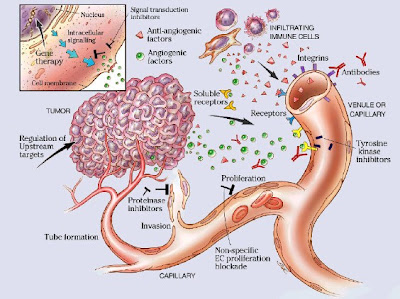Gallbladder Cancer Biography
Source(google.com.pk)
Bile from the liver is funneled into the gallbladder by way of the cystic duct. Between meals, the gallbladder stores a large amount of bile. To do this, it must absorb much of the water and electrolytes from the bile. In fact, the inner surface of the gallbladder is the most absorptive surface in the body. After a meal, the gallbladder's muscular walls contract to deliver the bile back through the cystic duct and eventually into the small intestine, where the bile can help digest food.
Demographics
About 5, 000 people are diagnosed with gallbladder cancer each year in the United States, making it the fifth most common gastrointestinal cancer. It is more common in females than males and most patients are elderly. Southwest American Indians have a particularly high incidence—6 times that of the general population.
Causes and symptoms
Gallstones are the most significant risk factor for the development of gallbladder cancer. Roughly 75 to 90 percent of patients with gallbladder cancer also have gallstones. Larger gallstones are associated with a higher chance of developing gallbladder cancer. Chronic inflammation of the gallbladder from infection also increases the risk for gallbladder cancer.
Unfortunately, sometimes cancer of the gallbladder does not produce symptoms until late in the disease. When symptoms are evident, the most common is pain in the upper right portion of the abdomen, underneath the right ribcage. Patients with gallbladder cancer may also report symptoms such as nausea, vomiting, weakness, jaundice, skin itching , fever , chills, poor appetite, and weight loss .
Diagnosis
Gallbladder cancer is often misdiagnosed because it mimics other more common conditions, such as gallstones, cholecystitis, and pancreatitis. But the imaging tests that are utilized to evaluate these other conditions can also detect gallbladder cancer. For example, ultrasound is a quick, noninvasive imaging test that reliably diagnoses gallstones and cholecystitis. It can also detect the presence of gallbladder cancer as well as show how far the cancer has spread. If cancer is suspected, a computed tomography scan is useful in confirming the presence of an abnormal mass and further demonstrating the size and extent of the tumor. Cholangiography, usually performed to evaluate a patient with jaundice, can also detect gallbladder cancer.
There are no specific laboratory tests for gallbladder cancer. Tumors can obstruct the normal flow of bile from the liver to the small intestine. Bilirubin, a component of bile, builds up within the liver and is absorbed into the bloodstream in excess amounts. This can be detected in a blood test, but it can also manifest clinically as jaundice. Elevated bilirubin levels and clinical jaundice can also occur with other conditions, such as gallstones.
On occasion, gallbladder cancer is diagnosed incidentally. About one percent of all patients who have their gallbladder removed for symptomatic gallstones are found to have gallbladder cancer. The cancer is found either by the surgeon or by the pathologist who inspects the gallbladder with a microscope.
Treatment team
The main member of the treatment team is the surgeon, since surgical removal of the cancer is the only measure that offers a significant chance of cure. Sometimes the cancer is too advanced such that surgery would be of no benefit. But the patient might suffer from jaundice or blockage of the stomach. In this case, the gastroenterologist or interventional radiologist may be able to provide non-surgical alternatives to address these complications. In limited scenarios, the oncologist or radiation therapist may treat the patient with chemotherapy or radiation therapy .
Clinical staging, treatments, and prognosis
Staging of gallbladder cancer is determined by the how far the cancer has spread. The effectiveness of treatment declines as the stage progresses. Stage I cancer is confined to the wall of the gallbladder. Approximately 25% of cancers are at this stage at the time of diagnosis. Stage II cancer has penetrated the full thickness of the wall, but has not spread to nearby lymph nodes or invaded adjacent organs. Stage III cancer has spread to nearby lymph nodes or has invaded the liver, stomach, colon, small intestine, or large intestine. Stage IV disease has invaded very deeply into two or more adjacent organs or has spread to distant lymph nodes or organs by way of metastasis .
Early Stage I cancers involving only the innermost layer of the gallbladder wall can be cured by simple removal of the gallbladder. Cancers at this stage are sometimes found incidentally when the gallbladder is removed in the treatment of gallstones or cholecystitis. The majority of patients have good survival rates. Late Stage I cancers, which involve the outer muscular layers of the gallbladder wall, are generally treated in the same way as Stage II or III cancers. Removal of the gallbladder is not sufficient forthese stages. The surgeon also removes nearby lymph nodes as well as a portion of the adjacent liver (radical surgery). Survival rates for these patients are considerably worse than for those with early Stage I disease. Patients with early Stage IV disease may benefit from radical surgery, but the issue is controversial. Late Stage IV cancer has spread too extensively to allow complete excision. Surgery is not an option for these patients.
Gallbladder Cancer
Sign Ribbon cells Horoscope Symbol Tattoos Research Zodiac Sign Ribbon Tattoos

Gallbladder Cancer
Sign Ribbon cells Horoscope Symbol Tattoos Research Zodiac Sign Ribbon Tattoos
Gallbladder Cancer
Sign Ribbon cells Horoscope Symbol Tattoos Research Zodiac Sign Ribbon Tattoos
Gallbladder Cancer
Sign Ribbon cells Horoscope Symbol Tattoos Research Zodiac Sign Ribbon Tattoos
Gallbladder Cancer
Sign Ribbon cells Horoscope Symbol Tattoos Research Zodiac Sign Ribbon Tattoos

Gallbladder Cancer
Sign Ribbon cells Horoscope Symbol Tattoos Research Zodiac Sign Ribbon Tattoos

Gallbladder Cancer
Sign Ribbon cells Horoscope Symbol Tattoos Research Zodiac Sign Ribbon Tattoos

Gallbladder Cancer
Sign Ribbon cells Horoscope Symbol Tattoos Research Zodiac Sign Ribbon Tattoos
Gallbladder Cancer
Sign Ribbon cells Horoscope Symbol Tattoos Research Zodiac Sign Ribbon Tattoos


















